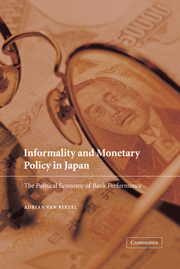Book contents
- Frontmatter
- Contents
- List of figures
- List of tables
- Acknowledgements
- 1 Introduction
- Part I Theory
- Part II The institutions and their policies
- 5 Informality, monetary authorities and monetary policy: the pre-1998 reform regime
- 6 Informality, banking crisis and financial reform: 1998 and beyond
- Part III Empirical evidence
- Bibliography
- Index
6 - Informality, banking crisis and financial reform: 1998 and beyond
Published online by Cambridge University Press: 22 September 2009
- Frontmatter
- Contents
- List of figures
- List of tables
- Acknowledgements
- 1 Introduction
- Part I Theory
- Part II The institutions and their policies
- 5 Informality, monetary authorities and monetary policy: the pre-1998 reform regime
- 6 Informality, banking crisis and financial reform: 1998 and beyond
- Part III Empirical evidence
- Bibliography
- Index
Summary
Financial regulation and supervision were designed with opaqueness and non-transparency in mind to provide an environment for political favours and concessions to be struck between politicians, government bureaucrats and the business sector.
T.F. Cargill (1998)Introduction
The structure of the Japanese financial system and monetary authorities as described in chapter 5 came under heavy pressure during the second half of the nineties. This was predominantly the result of the deteriorating situation of the Japanese banking industry, which was caused by the collapse of the so-called ‘bubble’ economy, the process of financial reform, a general policy of forbearance on the side of the supervisory authorities and, as I shall assert in this and the following chapters, the use of informal instruments and the existence of informal networks between the monetary authorities and banking sector. As regards the latter, informal instruments such as unpublished administrative guidance and transparent guidance in the form of circulars (tsūtatsu) often proved to be ineffective, and elaborate informal networks institutionalised by amakudari, gakubatsu, shukkō (ama-agari) and the MoF-tan system persistently blocked the adoption of timely and effective policy measures, as government bureaucrats entangled in these networks tried to protect both their own interests and those of the banking industry. This system of intertwined relations would be largely responsible for a great number of scandals that initiated institutional and organisational reforms at both the MoF and BoJ.
- Type
- Chapter
- Information
- Informality and Monetary Policy in JapanThe Political Economy of Bank Performance, pp. 165 - 252Publisher: Cambridge University PressPrint publication year: 2002



